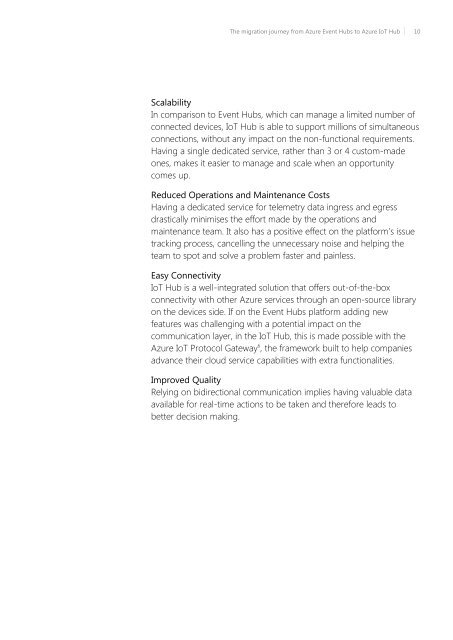JOURNEY FROM AZURE EVENT HUBS TO AZURE IOT HUB
IoT-iQuest-Whitepaper
IoT-iQuest-Whitepaper
Create successful ePaper yourself
Turn your PDF publications into a flip-book with our unique Google optimized e-Paper software.
The migration journey from Azure Event Hubs to Azure IoT Hub 10<br />
Scalability<br />
In comparison to Event Hubs, which can manage a limited number of<br />
connected devices, IoT Hub is able to support millions of simultaneous<br />
connections, without any impact on the non-functional requirements.<br />
Having a single dedicated service, rather than 3 or 4 custom-made<br />
ones, makes it easier to manage and scale when an opportunity<br />
comes up.<br />
Reduced Operations and Maintenance Costs<br />
Having a dedicated service for telemetry data ingress and egress<br />
drastically minimises the effort made by the operations and<br />
maintenance team. It also has a positive effect on the platform’s issue<br />
tracking process, cancelling the unnecessary noise and helping the<br />
team to spot and solve a problem faster and painless.<br />
Easy Connectivity<br />
IoT Hub is a well-integrated solution that offers out-of-the-box<br />
connectivity with other Azure services through an open-source library<br />
on the devices side. If on the Event Hubs platform adding new<br />
features was challenging with a potential impact on the<br />
communication layer, in the IoT Hub, this is made possible with the<br />
Azure IoT Protocol Gateway 6 , the framework built to help companies<br />
advance their cloud service capabilities with extra functionalities.<br />
Improved Quality<br />
Relying on bidirectional communication implies having valuable data<br />
available for real-time actions to be taken and therefore leads to<br />
better decision making.


